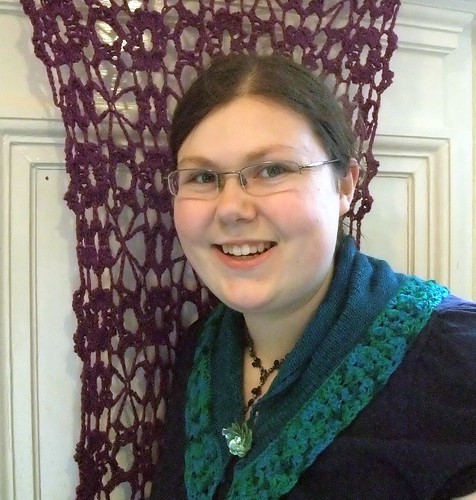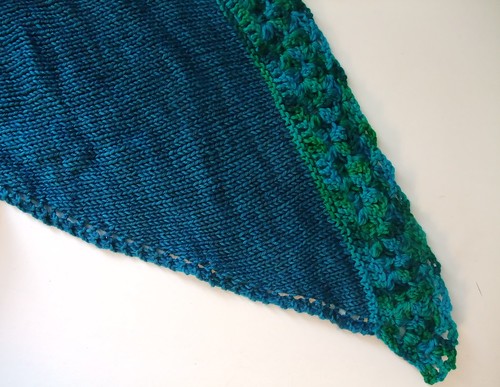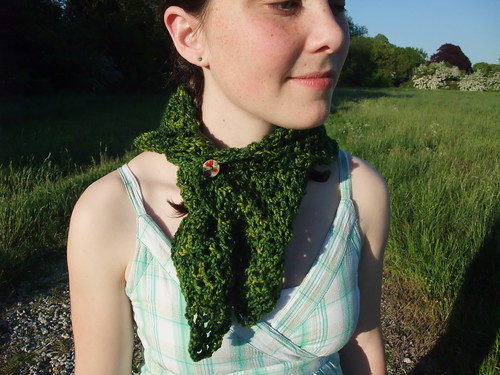I've spent the past year doing an MPhil, and consequently, this blog has been somewhat neglected. I have still been knitting and crocheting, but my room doesn't have very good light and the weather in Britain has been somewhat appalling over the past couple of months. Thus, I haven't really got my act together to get some of my creations photographed.
I've made several shawls this year. As I was giving one of them away to a friend, then that was the kick into action that I needed to get it photographed. But it was another rainy day, so I ended up shoved into the one picturesque corner of my room (a white painted fireplace), trying to get some decent shots. I took a lot, and ended up with three 'modelled' shots that I like, and more 'on a white background' shots that are decent.
Monday, 9 July 2012
The Shawls of 2012 (1. Buryan)
Posted by Sarah Francis at 14:45 0 thoughts
Tuesday, 3 May 2011
Endellion Shawl
This is a project on a Tuesday. Not a tool.

It was a struggle to photograph the entirety of the shawl, but hopefully you can build up a patchwork picture from the photos that I post. I took lots of photographs of the edging, because I think that it is quite beautiful, less of the garter stitch centre.
The Endellion shawl is a hybrid project - a garter stitch centre, based on the centre to the Multnomah Shawl by Kate Flagg, and then a crocheted flowery edging based upon the edging to the Midsummer Night's Shawl by Lisa Naskrent. It used one skein of Posh Yarn's Pamela in a colourway which I think was called 'Writing My Memoirs', but I'm not quite sure. Suffice to say it is dark blue, with 5% Stellina sparkle incorporated into the yarn. Initially, I was somewhat wary of a 'sparkly' yarn (they seem ubiquitous in UK indie dyers at the moment), but the sparkle isn't very obvious - it just gives it something a little magical when it catches the light, rather than looking like it has an obvious plastic strand in the yarn.

The intention with doing a hybrid knit-crochet project was to get the most out of both crafts - I wanted it to be densely stitched in the centre - hence the garter stitch, but lacy at the edge. I also wanted to take advantage of the low yardage and easier drape that you can achieve with dense stitches in knitting, so that there was more yarn left for the lacy crocheted flowers at the edge. I also wanted something slightly mindless at the beginning.
If you want to recreate the Endellion Shawl, then this is a rough guide: you'll need to knit the Multnomah centre until you have about 220 sts, then switch to looking at the Midsummer Night's pattern. I did three rows (because I hadn't got enough sts, but just do as many rows as you need to get the right number) of dc, adding increases at the centre like on the pattern (the chart is super helpful). Then I did Rows 5-7 of the edging twice, if you look atht the picture above, then you'll be able to see how I added extra increases at the centre.

This was a fun project- slightly mindless with all the garter stitch, but a great piece of problem solving to work out how to make the edging work. It also reminded me how awful I am at guessing how much yarn is left in a ball - I only did the edging once as I thought that I was about to run out, so I bound off. Then I realised that I had a sizable ball left so I decided to keep crocheting until I ran out - which was almost exactly after I'd done a whole repeat of Rows 5-7. Perfect!
Tuesday, 29 March 2011
Multnomah Shawl (and Flamies)
This post is mainly about my experience knitting the Multnomah shawl. But before I do that, I'm going to point you towards the Crochet Liberation Front's annual Flamie Awards, where my Esmée Cardigan has been nominated for 'Best Design - Adult Garments'. Looking down the list of nominations in the voters' guide, its a great list of some of the best designs and contributions to the crochet world over the past year. And being the Crochet Liberation Front, it does make me a little sad that I'm tacking it onto a post about knitting. But I'm somewhat shy about 'vote for me!' self-promotion (which is why it has taken me until the end of the voting period to actually make this post), and I didn't want to put it on a stand-alone post. And crocheters, do not fear, I am crocheting as I type this post (well, during thinking time), so I should have some crocheted loveliness to post up soon. Also, I'm going to rework the Esmée Cardigan for self-publishing in the summer once I get the rights back, so my brain will be switching to more thoughts about crochet over the coming months (as well as lots and lots of thoughts about final exams).
Anyway, onto Multnomah.

It was quite a pleasing knit, all in all. I used almost a whole skein of Wollmeise Sockenwolle 80/20 Twin We're Different in Pfefferminz Prinz, and 3.25mm needles.

The needles provided the only problem for the knit. When I started, I only had my 3.25mm circular needles with a 30cm cord. These are some old needles that I inherited from my grandmother - so they're a little sticky, and the cord isn't particularly flexible. Also, despite measuring them in a needle gauge, I still wasn't sure if they were 3.25mm. The pattern told me that I would need a longer cord so I promptly ordered some nice Addi premiums online with a 100cm cord. They took longer than expected to arrive, by which time I had a nicely scrunched up shawl on the little circulars, having reached almost the edge of the garter stitch section. Thankfully, when the needles arrived then they were the same size as those I had already been using, and the shawl doesn't seem to show any evidence that two different needles were used.

It was quite mindless, especially the garter section. The feather and fan provided some interest, but it suited the end of term, when I didn't really want to be spending a lot of my time focussing upon my knitting.

As you can see in the above photo, the variegated yarn striped or changed colour nicely, without any large patches of pooling.
One of the next posts will hopefully contain one of the two knitting patterns I have ready to go - I've typed it all out, reknitted it, and am now just waiting for a sunny day when I can photograph my samples.
Posted by Sarah Francis at 18:40 1 thoughts
Labels: crochet liberation front, knitting, multnomah, shawl, wollmeise
Sunday, 23 May 2010
Heidi Shawl
A flexible shawl, suitable for snuggling up on a cold winter's day, or covering the arms in the summer.
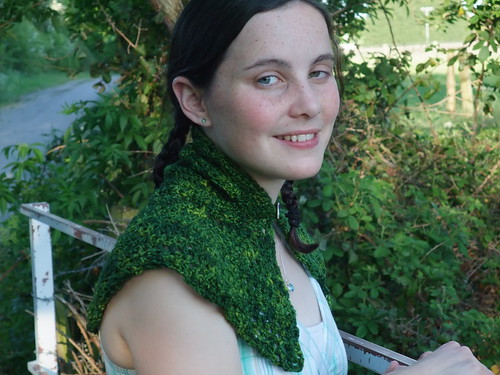 The example in the pictures was made under time-pressure, so acts as a small capelet or scarf, with the button anchoring the shawl in place. However, the pattern is expandable so that a larger shawl can be made, it could also act as a bolero if you sew up the underarms.
The example in the pictures was made under time-pressure, so acts as a small capelet or scarf, with the button anchoring the shawl in place. However, the pattern is expandable so that a larger shawl can be made, it could also act as a bolero if you sew up the underarms.
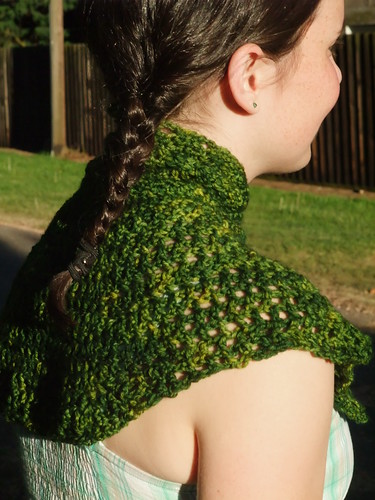
The shawl is made up of a dense stitch pattern at the top of the shawl, changing into a wider mesh pattern about halfway down.
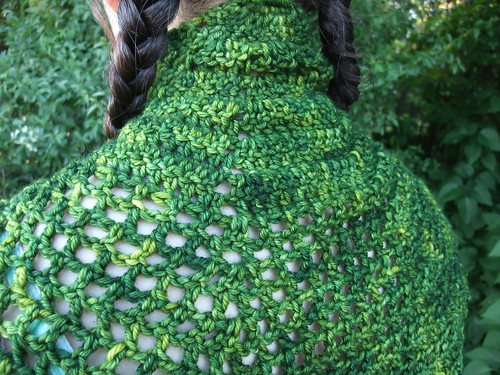

About 1 skein to 2 skeins of madelinetosh tosh DK in Jade (11wpi, 206 metres per skein). Pictured example used 1 skein.
5mm hook
Button
Needle to weave in ends and attach button
Pattern (uses US terms):
Special stitches:
Dc2tog: yarn over, insert in stitch, yarn over, pull over first loop, yarn over, pull through 2 loops on hook, yarn over, insert in next stitch, yarn over, pull over first loop, yarn over, pull through 2 loops on hook, yarn over, pull through all 3 loops on stitch.
The 3 ch at beginning of each round are counted as 1 stitch, as is each subsequent chain in pattern (so 3ch ch1 dc dc ch1 dc would be counted as 6 stitches). Chains in the first half of the pattern are counted as increases and should be stitched into in the next row (look at the loops from the previous row, not the stitches).
There are charts below the pattern for anyone who gets lost!
Dense pattern:
Row 1: magic loop, work 12 sc onto loop, and pull closed. Put finger in centre of loop so that it does not shut completely.
Row 2: 2 dc into first 6 stitches, turn leaving rest of stitches unworked (12 stitches)
Row 3: 3 ch, *ch1, dc into next 2 stitches*, repeat *to* 4 times, ch1, dc into last stitch, turn (18 stitches)
Row 4: 3 ch, *ch1, dc2tog, 2dc in chain space*, repeat *to* 4 times, ch 1, dc into last stitch, turn (23 stitches)
Row 5: 3 ch *ch1, dc into next 4 stitches*, repeat *to* 4 times, ch 1, dc into last stitch, turn (28 stitches)
Row 6: 3 ch, *ch1, dc, dc2tog, dc, 2dc in chain space* repeat *to* 4 times, ch 1, dc into last stitch, turn (33 stitches)
Row 7: 3ch, *ch1, dc in next 6 stitches*, repeat *to* 4 times, ch 1, dc into last stitch, turn (38 stitches)
Row 8: 3 ch, *ch1, dc in next 2 stitches, dc2tog, dc in next 2 stitches, 2dc in chain space* repeat *to* 4 times, ch 1, dc into last stitch, turn (43 stitches)
Row 9: 3 ch, *ch1, dc in next 8 stitches*, repeat *to* 4 times, ch 1, dc into last stitch, turn (48 stitches)
Row 10: 3ch, *ch1, dc in next 3 stitches, dc2tog, dc in next 3 stitches, 2dc in chain space*, *to* 4 times, ch 1, dc into last stitch, turn (53 stitches)
Continue this pattern of increases as long as desired, so that:
Even row: 3ch *ch1, dc in next (even number) stitches*, repeat *to* 4 times, ch1, dc into last stitch, turn (number8 stitches)
Odd row: 3 ch *ch1, dc in next (number of dcs in last odd row +1) stitches, dc2tog, dc in next (number of dcs in last odd row +1), 2dc in chain space*, repeat *to* 4 times, ch1, dc into last stitch, turn (number3 stitches)
Mesh pattern:
Row 1 (should come after an even row): 4ch,*dc, ch over next stitch* repeat *to* until reach ch space, 2dc in chain space, ch1, repeat this pattern until reach end. Do not do 2ch in final chain space but ch1 and then 1dc in last stitch, turn
Row 2: 4ch, *dc in top of previous row's dc, ch over previous row's chain* repeat *to* until reach previous row's 2dc increase – dc in first dc, ch1 and place marker over this stitch, dc in second dc, ch1, continue *to*, repeat until reach end, ch1, dc in last stitch, turn
Row 3: 4ch, *dc in top of previous row's dc, ch over previous row's chain* repeat *to* until reach marker placed in previous row – remove and 2dc in ch space, ch1, continue *to* and increases until reach end, ch1, dc in last stitch, turn.
Repeat rows 2 and 3 until desired length. There should be 4 places where increases are occurring.
Weave in ends. Sew button at the bottom of the dense pattern, or wherever is convenient for neck width.
Charts:
This chart shows the *to* units of the dense pattern. The arrows show the direction of working.
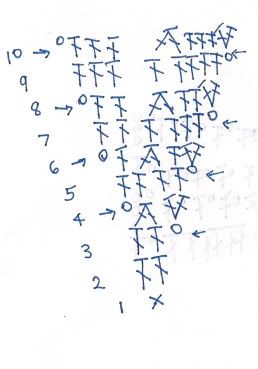
This chart shows the changeover from the dense pattern to the mesh pattern.
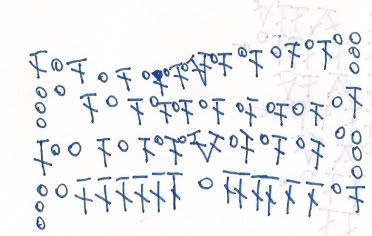

Posted by Sarah Francis at 20:06 2 thoughts
Labels: capelet, crochet, heidi shawl, madelinetosh, pattern, Scarf, shawl

